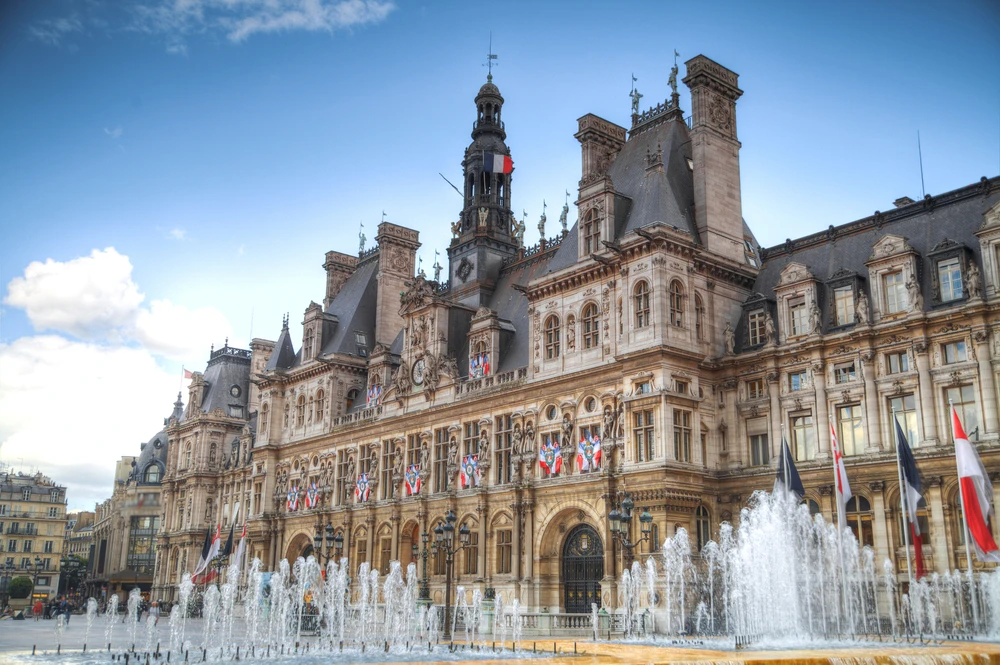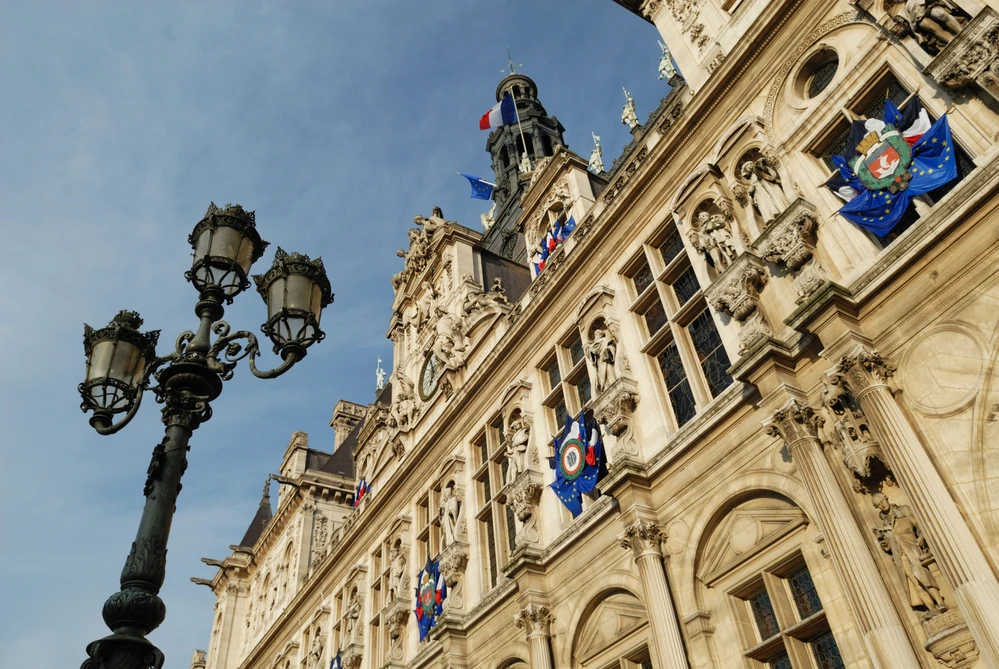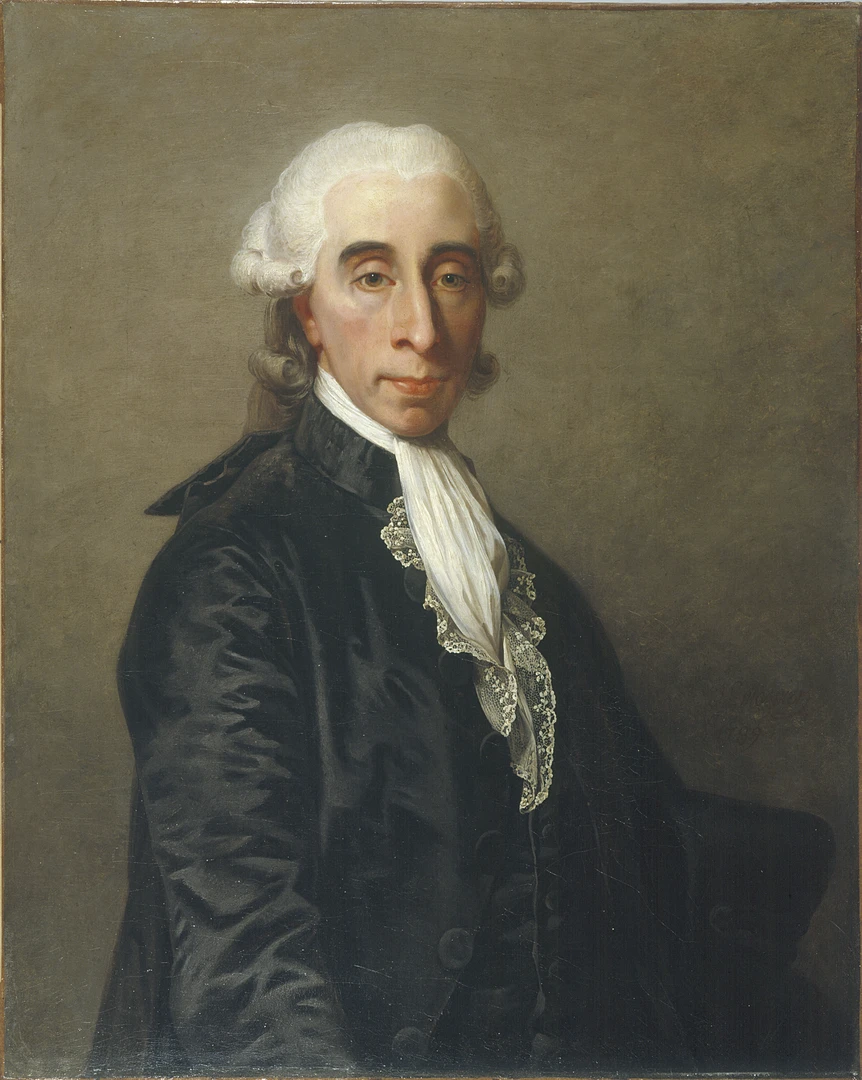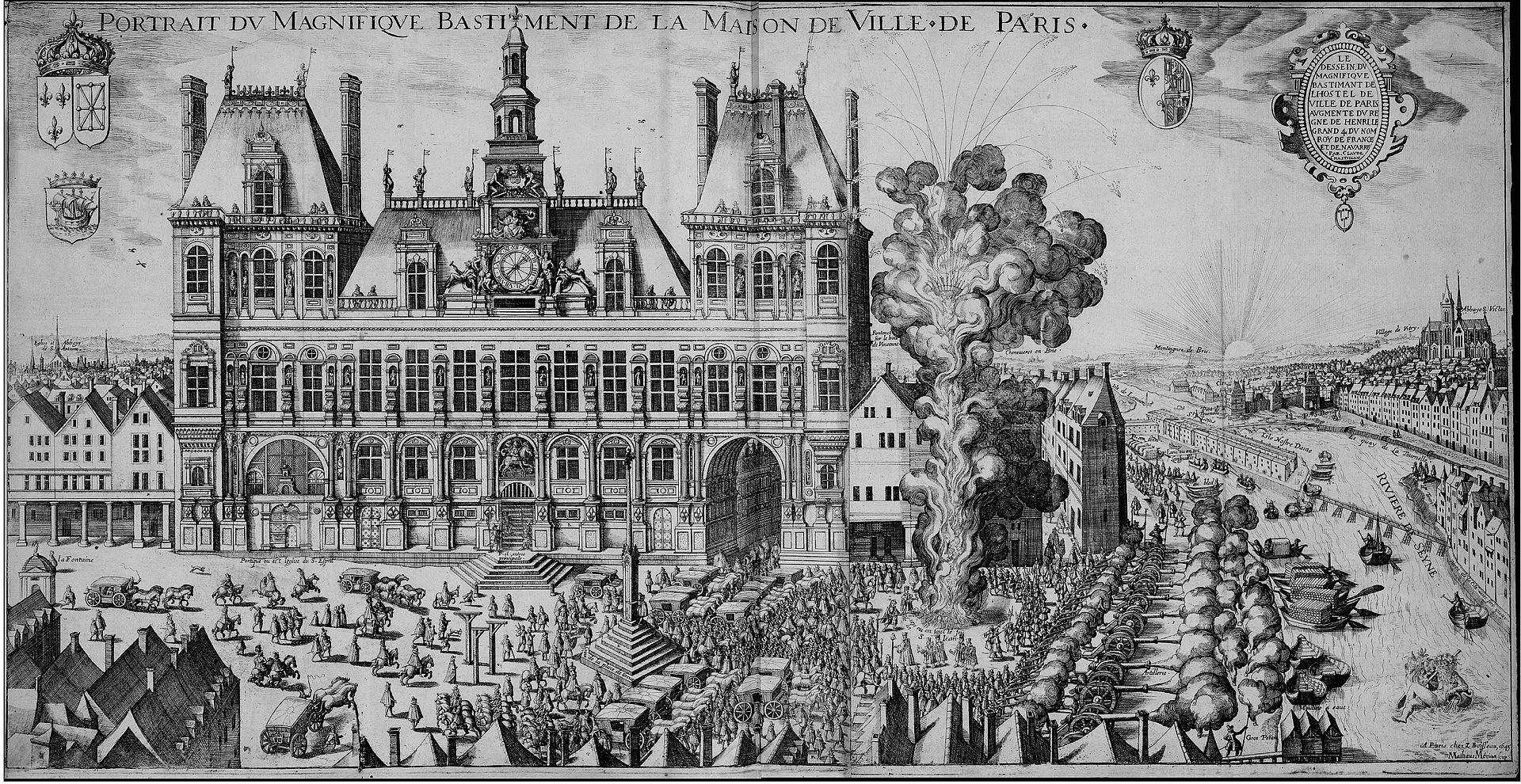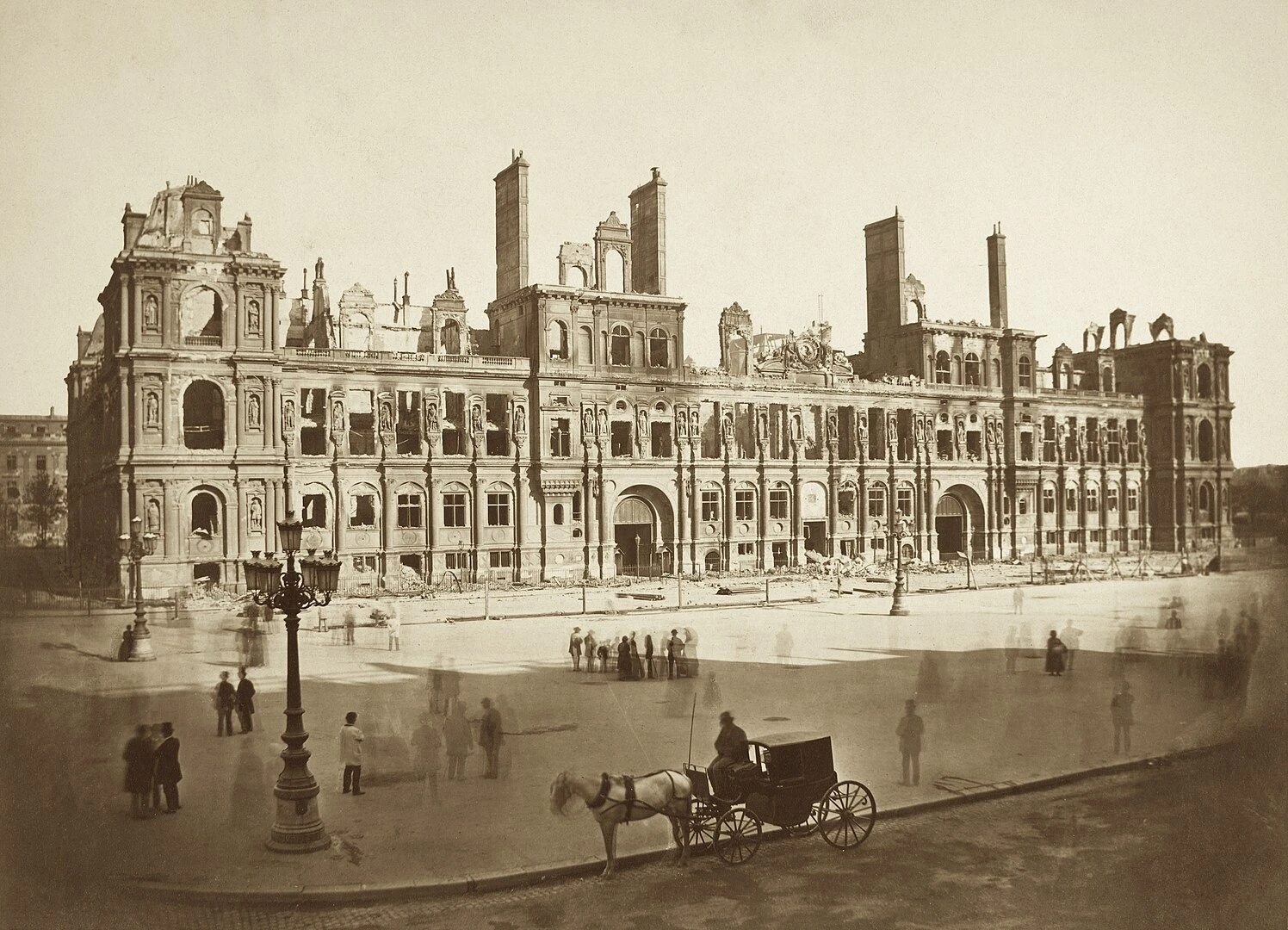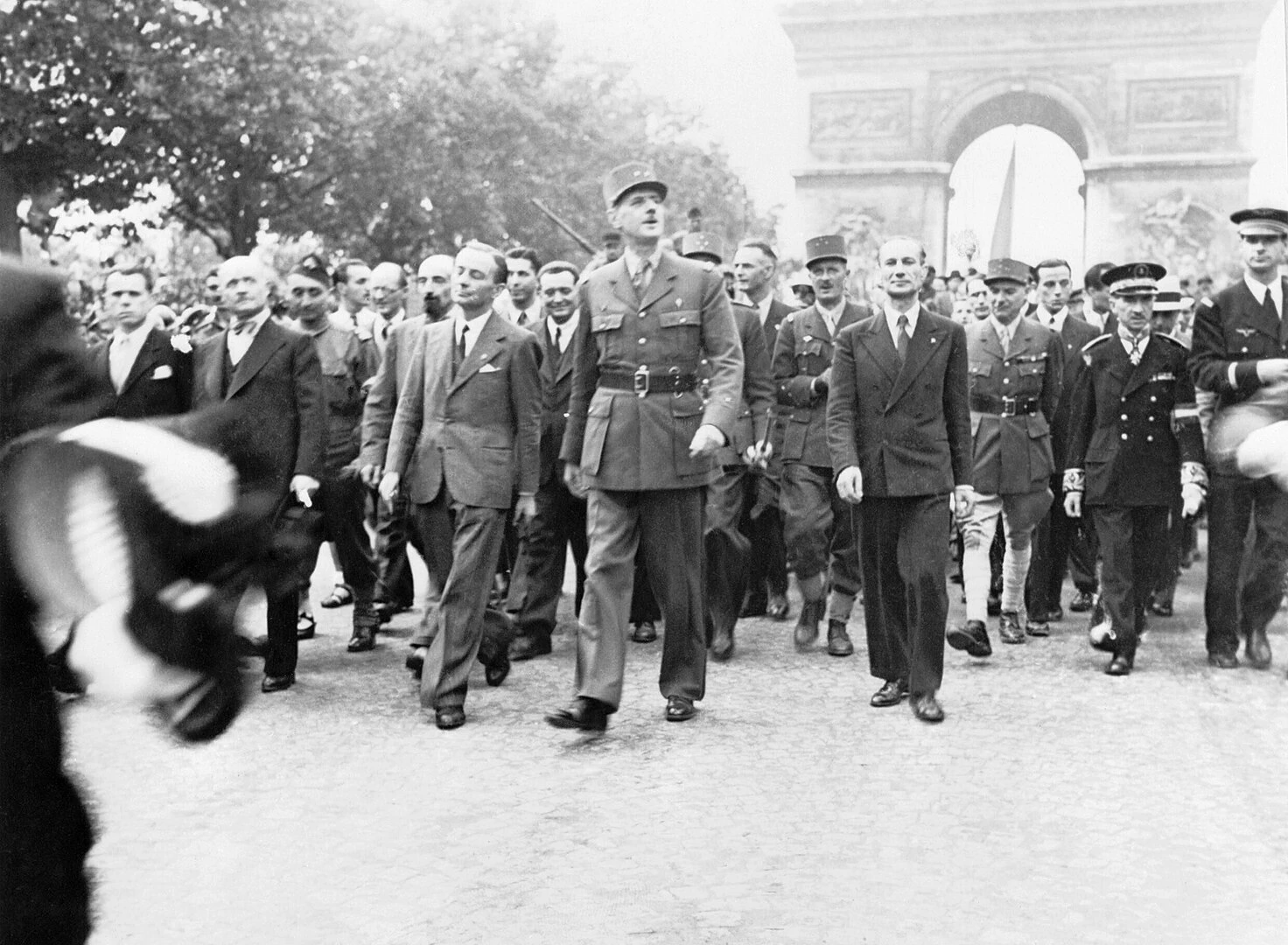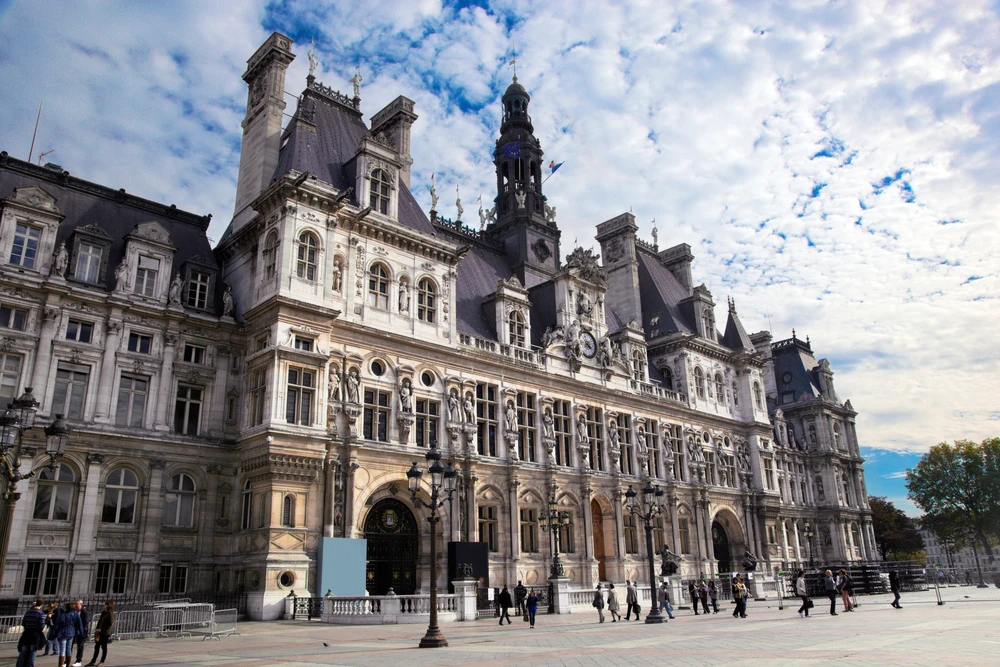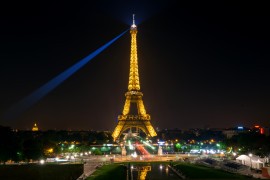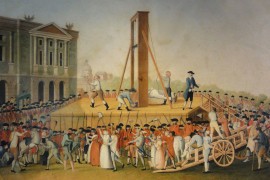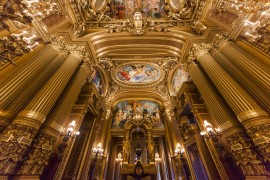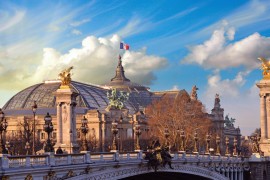Paris City Hall: capital of France
Paris City Hall decked out in flags. Photo chosen by monsieurdefrance.com: Lindrik via depositphotos.
Paris City Hall: Europe's largest city hall
Paris City Hall was built on the ruins of the previous city hall, destroyed by fire during the Commune in 1871. It is the largest in Europe, with a total surface area of 55,000 m2. Erected between 1874 and 1882, its last major construction was added in 1937: a bunker in case of bombardment. Its immense neo-Renaissance facade is 143 metres long and 18.50 metres high on the lower facades, and 25 metres high on the corner pavilions. The campanile rises to a height of 50 metres, and is surrounded by statues of work and learning, just above the motto of France: Liberté Egalité Fraterinté. Above it sits the crowned city of Paris, holding the coat of arms. Below her are two reclining statues: vigilance and prudence.
The pediment of the town hall. Below, lying vigilance and prudence, supporting the clock, work and education. Above, the city of Paris. Photo chosen by monsieurdefrance.com: lucianmilasan via depositphotos
The statues at Paris City Hall.
Statues all along the façades depict virtues, cities, the arts, great figures from the history of Paris, scientists, artists, industrialists and political figures. For example, on the first level of all facades, you can see Voltaire, Ambroise Paré, Philibert de Lorme, Nicolas de Condorcet and Antoine de Lavoisier. There are few women, but you can also see Manon Roland, Madame de Sévigné and George Sand. For the big cities, they're on the 2nd level. From left to right on the main facade are Amiens, Rouen, Le Havre, Caen, Le Mans, Rennes, Brest, Paris, Bourges, Orléans, Tours, Poitiers, Limoges, Toulouse and Montpellier. Other facades include Rennes, Nice, Marseille, Reims, Lille and Besançon. Science, civil engineering, agriculture and industry are also represented. Arts such as tragedy, sculpture, engraving, poetry and history are also represented.
Statues abound on the facades of Paris City Hall. Photo chosen by monsieurdefrance.com ventdusud via depositphotos
The interior is very busy, in the style of the late 19th century. The reception hall is quite spectacular. This is where Paris officially received its most famous guests. It was here, too, that General de Gaulle, arriving for the Liberation of Paris in 1945, gave his famous speech before marching the following day with a crowd of a million people between the Arc de Triomphe and Notre Dame. The Salle des Fêtes is adorned with numerous paintings and sculptures. On the voussoirs and ceiling, 16 regions of France are represented, including Lorraine, Normandy, Brittany, Provence and Gascony, as well as French Guiana and Algeria, recently conquered when the town hall was built. The arts are also represented on various panels.
The interior of the salle des fêtes at Paris City Hall. Detail. Photo chosen by monsieurdefrance.com: isogoodvia depositphotos
The town hall garden
It's not always well known, but Paris City Hall boasts a small garden (1326 M2) officially named "jardin de la nueve", after the company of the 2nd D.B. that liberated the city hall on August 24, 1944. Adorned with numerous plants, including roses, and an equestrian statue of Etienne MARCEL (1310-1358), who was provost of Paris, otherwise known as mayor.
The Place de l'Hôtel de Ville in Paris is called :
L'esplanade de la Libération. For a long time, it was called Place de grève, because a strike - a sort of sandy, gravelly expanse - led to the Seine. Goods were unloaded here. It was famous for the capital executions that took place there right up to the French Revolution. In fact, it was here that the first guillotine execution took place in 1792 (the executioner was booed because it was too quick). It became Esplanade de la Libération in 2013 to pay "homage to the Resistance fighters, the Free French, the Allies and all the insurgents who liberated Paris on the night of August 24-25, 1944".
Paris and its city hall: a turbulent history
The origins of Paris City Hall
It was in 1357 that Etienne MARCEL (c. 1310-1358), Provost of Paris, bought "la maison aux piliers" to house the forerunner of the Paris municipal authorities. The site is located on the banks of the Seine, near the Quai de la mégisserie (named after the cows and oxen that used to disembark there and roar loudly before ending up on the butcher's stalls). Nearly two centuries later, as it fell into ruin, the Parisian bourgeoisie obtained the approval of François 1er to build a town hall. It was designed in the Renaissance style by the Italian architect Bocador. The foundation stone was laid on July 15, 1533, and work began. It would not be completed until over 100 years later, in 1628. It has to be said that during these years, French history was full of convulsions and we had other things to do: the War of Religions (including the sad Saint Barthélémy), the siege of Paris by Henri IV... Work is carried out in short periods. In fact, it was for the construction of the Hôtel de Ville that Charles Leconte broke new ground in timber transport, managing to float it down the Seine in 1547. Deliveries were quicker and easier. This method, which was continued long after his death, helped to develop the marine industry by bringing wood from far inland by floating it on rivers.
Provost Etienne MARCEL in the center of this painting by Jules Etienne MELINGUE / Illustration chosen by monsieurdefrance.com: wikicommons via Wikipedia.
The town hall until the Paris Commune.
At the beginning of the 17th century, the Paris town hall was completed. It dominates the Place de Grève. It is an important place in the history of France, as well as being a major landmark in the history of Paris. Louis XV came here on several occasions to celebrate events. On July 17, 1789, the day after the storming of the Bastille, Louis XVI made a less cheerful visit. He was received by the first mayor in Paris history, astronomer Sylvain BAILLY (1736-1793), and La Fayette, commander of the National Guard. Two days earlier, on July 15, the last provost of Paris, Jacques de FLESSELLES, had been assassinated while trying to dissuade the crowd from going to the Bastille. Sylvain BAILLY was proclaimed mayor of Paris, and Louis XVI was presented with a fait accompli. It was at this point that the three colors were first seen together on a cockade, which the king was asked to wear on his hat, which he did. The three colors symbolize the union of Paris (red and blue) and the monarchy (white).
Jean Sylvain BAILLY the first mayor of Paris / Illustration chosen by Monsieurdefrance.com: Portrait of Jean-Sylvain Bailly (1736-1793), scholar and politician; mayor of Paris from 1789 to 1791 Jean Laurent MONNIER via wikicommons / Wikipedia.
Little did Louis XVI and Sylvain Bailly know that the Revolution would sweep them off their feet, and that they would be guillotined a few years later. It was from the Hôtel de Ville that the first groups set out to storm the Château des Tuileries, leading to the fall of the Monarchy on August 10, 1792. Jean Sylvain BAILLY had one admirable last word before he perished. As a man mocked him for shivering, saying "tu trembles Baiily!", the Mayor of Paris replied "oui! But it's from the cold, my friend". Robespierre was arrested at the Paris Town Hall on July 9, 1794. He tried to commit suicide in the Salon de l'Egalité with his pistol, but missed. He was guillotined a few hours later. It was the end of the Terror, the bloodiest part of the French Revolution.
The 17th-century town hall on the Place de grève . Illustration chosen by Monsieur de France: Hôtel de Ville de Paris et la place de grêve sous le règne de Henri IV. Based on a drawing by Claude Chastillon, engraving by Matthäus Merian, Boisseau 1645 via Wikipedia / Wikicommons
In the 19th century, the Hôtel de Ville was always at the forefront of current events. It was here that the July Monarchy was installed in 1830. Louis Philippe 1st (1773-1850) arrived from the Tuileries and appeared on the balcony. In 1834, the town council was installed here. In 1852, it was decked out in the colors of the brand-new Emperor Napoleon III (1808-1873), and Queen Victoria was received with great pomp and ceremony .
Destruction during the Commune
Paris City Hall after the fire that destroyed it in 1871. Photograph chosen by Monsieur de France via wikicommons / Wikipedia: By Auguste Hippolyte Collard
In 1871, during the Paris Commune, not only the town hall, but also the Palais de Justice and the Palais des Tuileries were set on fire. The Palais des Tuileries was never rebuilt. In the fire at the Hôtel de Ville, all the archives of the city of Paris were destroyed, making it difficult to trace the genealogy of a Parisian today. The decision was quickly taken to rebuild the building on the same site, keeping the Renaissance style it had been built in since 1533. Théodore BALLU and Edouard DEPERTHES were appointed architects. Work lasted from 1878 to 1882. It was here that the Prefect of Paris took up residence until 1977. The city of Paris was without a mayor for all these years. The office of the Prefect of the Seine became the mayor's office in 1977, withthe first election of a Paris mayor by universal suffrage, in this case Jacques CHIRAC (who became President of the Republic in 1995).
The Liberation of Paris
De Gaulle walks down the Champs-Elysées the day after his famous speech from Paris City Hall. Photo chosen by monsieur de France: wikipedia / Wikicommons
On August 25, 1944, as the 2nd D.B. entered Paris, which was in the throes of an uprising, the Parisian Liberation Committee took possession of the town hall, which had been taken by the 9th company of the 2nd D.B. the previous day (the famous Nueve), and harassed the Nazi soldiers by shooting at them from the windows. Since August 24, over 600 barricades have been erected in Paris. It was here that General de GAULLE arrived in Paris and delivered his famous speech : " Paris, Paris outraged, Paris broken, Paris martyred, but Paris liberated! Liberated by itself, liberated by its people with the support of the armies of France, with the support and support of the whole of France: in other words, of France fighting" .
Paris City Hall today / Photo chosen by monsieurdefrance.com: Photocreo via depositphotos.
How do I get to Paris City Hall?
Address
The address of the Paris City Hall is: Esplanade de la Liberation 75 004 PARIS. The public can enter via the following addresses: rue Lobeau or 29 rue de Rivoli in Paris.
Tours of the Town Hall are available on prior registration with the Protocol Department or during the European Heritage Days.
Metro / RER / BUS
Metro: 1 (Hôtel de Ville stop) and 11.
Bus: lines 38, 67, 69, 74, 75, 76 and 96.
RER: Line B

